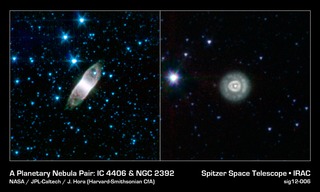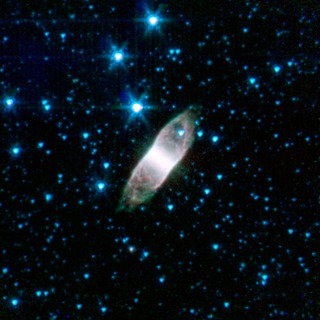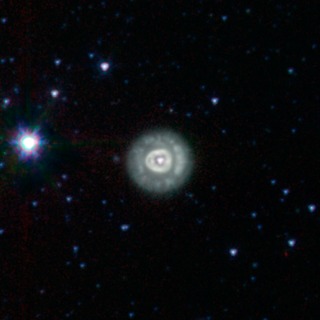
Credit: NASA/JPL-Caltech
Observation • July 2nd, 2012 • sig12-006b
sig12-006b
This ball of glowing gas is known as NGC 2392. It is found in the constellation Gemini and is about 3,000 light years away. The pioneering astronomer William Herschel first discovered it in 1787 using an early telescope that revealed very little of the structure we see in this infrared image from NASA's Spitzer Space Telescope.
When stars like our sun reach the end of their nuclear fuel burning lifetimes they make one final grab for glory. The outer layers of these stars, which have swollen to something approaching the size of Earth's orbit, get blown into space forming what has been dubbed a "planetary nebula." The expelled gas from the star glows brightly, illuminated by the ultraviolet light from the surviving stellar core, known as a "white dwarf."
Astronomers think it is common for stars to lose their material in winds that preferentially blow out along their axes of rotation, effectively carving out a cylindrical, sometimes rod-shaped, cavity. When these structures are viewed end-on, as with NGC 2392, they take on the appearance of a strangely-structured ball.
The somewhat misleading term "planetary nebula" actually comes from Herschel himself. After observing a number of round, ball-like objects (including NGC 2392), he thought their appearance was roughly similar to the newly-discovered planet Uranus. Because of that similarity, he applied the description of "planetary" to these nebulae.
The term planetary nebula has stuck, even though we now know these stellar remnants have little to do with planets. The only connection is that some of the elements recirculated back into interstellar space may one day end up forming new stars and planetary systems.
About the Object
- Name
- NGC 2392
- Type
- Nebula > Type > Planetary
- Distance
- 2,800 Light Years
Color Mapping
| Band | Wavelength | Telescope |
| Infrared | 3.6 µm | Spitzer IRAC |
| Infrared | 4.5 µm | Spitzer IRAC |
| Infrared | 8.0 µm | Spitzer IRAC |
Astrometrics
- Position (J2000)
- RA =7h 29m 10.7s
- Dec = 20° 54' 42.7"
- Field of View
- 4.0 x 4.0 arcminutes
- Orientation
- North is 79.2° left of vertical






